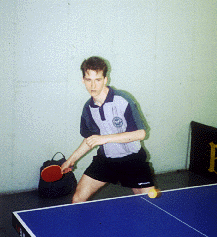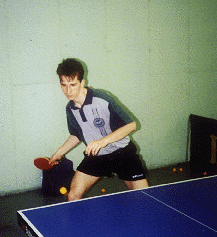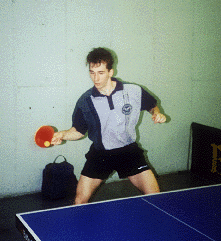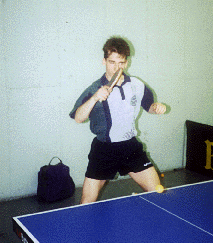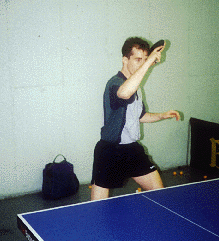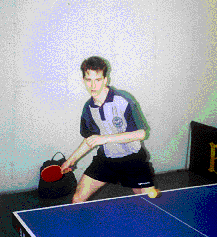|
|
||||||||||||||
|
|
||||||||||||||
|
|
FOREHAND SMASH AGAINST BACKSPINBy Larry Hodges It's been called a "dying art," due to the loop-kill. Yet, it's one of the most dynamic point-winning shots in the game, and the scariest shot for a chopper to contend with. Playing a chopper without this shot is like running a mile with a bad limp—a severe handicap. Additionally, not all players have the ability to loop-kill effectively. Since much of the power of a loop goes into topspin, there is less power for speed. Many players, especially older ones, do not have this extra power to spare. Others simply do not have the ability, time or interest to develop a loop-kill, and so smashing is simply the better option. (For one thing, it's a simpler shot to learn.) Still others are simply more talented at smashing than at looping. Besides, what can be more devastating to an opponent who's spent years developing his loop against backspin, only to have you smash his push like it had no backspin at all! When is the best time to smash against backspin? Obviously, when the ball is high. However, there are two other considerations. First, a deep ball is harder to smash than a ball that doesn't land very deep on the table—a "medium-deep ball." A good smasher will often smash a ball that lands in this middle area, even if it is low. Deep balls, even slightly high ones, can be more difficult to smash than low, medium-deep ones. Second, a player has to judge how well he has read the spin. Smashing is a precision shot, and if you read the spin well, you can smash even a pretty low backspin pretty well, especially if it doesn't land very deep on the table. If you think you've read the spin very well, then don't be afraid to go for it! There's nothing more satisfying than reading a low but medium-deep backspin perfectly, smashing it cleanly, and seeing the look on your opponent's face. (For one thing, many modern players don't realize how much easier these medium-deep balls are, and if you smash his "low ball" in, he doesn't know what to do next. Talk about intimidation!) A good way to practice this shot is to set a Newgy robot on backspin, slightly high, and take your shots! Experiment with the depth of the robot's backspin shot, and test the difference between smashing deep and medium-depth balls. Practice smashing to all parts of the table. It's all about precision and control. You might also try hitting at less than full power (for consistency), or quick off the bounce (to rush an opponent). In the five photos below (plus an animated sequence!), U.S. Collegiate Singles & Doubles Champion Sean Lonergan demonstrates his forehand smash against backspin, using a Newgy robot. (Editor's Note: There are 6 GIF files that Larry has included with this article. The first five are still pictures, and are great for studying the details of each phase of the stroke. The last picture is an animated GIF made from the 5 previous files. This file takes a while to load, but once loaded it will "play" all 5 still pictures in sequence, giving motion to the pictures and providing the viewer with a good idea of the "feel" of the motion and how one phase of the stroke leads into the next phase.) Photo 1: Backswing Begins. Sean's weight is moving toward back foot. His waist is twisted backward, so that his right leg points sideways. His racket has been brought back, just below where contact point will be, with tip slightly down. Photo 2: Forward Swing Begins. Most of Sean's weight is now on right leg, and is about to transfer forward. His waist is about to untwist. He has turned his head to keep the ball directly in front of both eyes. He has also closed his racket. (Not all players do this.) Photo 3: Contact. Sean's weight is transferring to his left leg. His right leg is now pointing mostly forward. His waist has untwisted. Just before contact, his forearm snaps into ball. His racket has moved slightly upward to meet ball, and opens to about 90 degrees with the floor. He is watching the spot where ball was just before contact—contact happens too quickly to actually see, so he instead is getting a very good look at it just before contact. Contact is at the top of the bounce. Contact itself is has a very slight upward motion (since racket started just below the ball, and rose to meet it), giving the ball a light topspin. However, most of the force is forward, so nearly all of the power translates into speed. Photos 4–5: Follow-through. Sean spins around on his waist, with racket moving around and up. His weight has transferred to his left leg. He finishes standing very close to where he started stroke, so even if the ball comes back, he is ready for the next shot.
Courtesy of Newgy Industries Copyright © 2000 Newgy Industries. All rights reserved. |
|||||||||||||
|
Last Update : 06 November, 2002 Copyright © 2001-2006 Ertan Patir Webmaster : |

